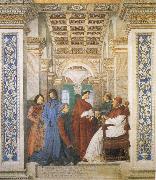
|
Melozzo da Forli
|
|||
|
|
|||
| 1438-1494 Italian Melozzo da Forli Location Melozzo came, it is supposed, of a wealthy family named Ambrosi from Forl??. Nothing is known about his early years, and it is only a hypothesis that he formed at the Forlivese school of art, then ruled by Ansuino da Forl??, for they were both influenced by the Mantegna manner. It has been said that he became a journeyman and color-grinder to some of the best masters, in order to prosecute his studies; this lacks confirmation. His presence his first mentioned in his birthplace in 1460 and again in 1464. Around this period, together with Antoniazzo Romano, frescoed the Bessarione chapel in the basilica dei Santi Apostoli in Rome. Melozzo presumably moved to in Urbino between 1465 and 1475: here he met the highly theoretical and mathematical Piero della Francesca, who profoundly influenced the Melozzo style and use of perspective. He should have also studied the architectures by Bramante and other Flemish painters then working for the duke Federico da Montefeltro: perhaps Melozzo worked with Justus of Ghent and Pedro Berruguete to the decoration of the studiolo of the famous Ducal Palace of the city. In 1475 Melozzo transferred to Rome, though some authorities claim his presence in Rome ten (or five) years earlier to work in the Basilica di San Marco. In 1477 he finished his first major work in the new seat, a fresco now transferred to canvas and placed in the Pinacoteca Vaticana, representing the appointment of Bartolomeo Platina by Sixtus IV as librarian of the restored Vatican Library. In 1478 he was one of the original members of the academy of St Luke, founded by Sixtus IV to unite the main painters working in the city. About 1480 Melozzo was commissioned by Pietro Riario to paint the vault of the apse in the basilica dei Santi Apostoli in Rome, his subject being the Ascension. The figure of Christ is so boldly and effectively foreshortened that it seems to burst through the vaulting; this fresco was taken down in 1711, and the figure of Christ is now in the Quirinal Palace; while some of the other portions, almost Raphaelesque in merit, are in the sacristy of St Peter: a hall in the Vatican Museums is designed for angels and apostles by Melozzo taken down the same fresco. Another work of the Roman period is an Annunciation that can still be seen in the Pantheon. Melozzo last work in Rome is a chapel, now destroyed, in the church of Santa Maria in Trastevere. After the death of Sixtus IV in 1484 he moved from Rome to Loreto. Here he painted the fresco in the cupola of San Marco sacristy in the basilica della Santa Casa, commissioned by cardinal Girolamo Basso della Rovere. It is one of the first examples of a cupola decorated both with architectures and figures, with a profound influence from the Camera Picta by Mantegna. In 1489 Melozzo returned in Rome. In this second period he probably drew some cartoons for the mosaics of Jesus blessing in the St. Helen chapel of the basilica of Santa Croce in Gerusalemme. Pope Sixtus IV appoints Bartolomeo Platina prefect of the Vatican Library, c. 1477 (fresco) (Vatican Museums)Melozzo also painted the cupola of the Capuchin church at Forl??, destroyed in 1651; and it has been said that he executed at Urbino some of the portraits of great men (Plato, Dante, Sixtus IV, etc.) which are now divided between the Barberini Palace and the Campana collection in Paris. In 1493 he worked to some ceilings of the Palazzo Comunale of Ancona, which have gone lost. Eventually Melozzo moved to Forl??, where, together with his pupil Marco Palmezzano, decorated the Feo Chapel in the church of San Biagio, which was destroyed during World War II. The Pinacoteca of Forl?? houses a fresco by Melozzo, termed the Pestapepe, or Pepper-grinder, originally painted as a grocer sign; it is an energetic specimen of rather coarse realism, now much damaged. It is the only non-religious subject by Melozzo. | |||
|
|
|||
|
Sixtus IV,his Nephews and his Librarian Palatina new9/Melozzo da Forli-487733.jpg Painting ID:: 33388 |
mk86 c.1480 Fresco,Transferred to canvas. 370x315cm Rome,Musei Vaticani,Pinacoteca Vaticana | ||
|
|
|||
|
Also Buy::. For Following Paintings / Artists / Products, Please Use Our Search Online: |








